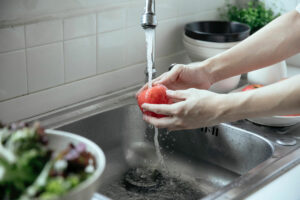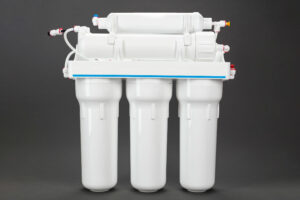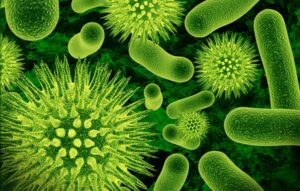 With concerns about water contaminants on the rise, it’s no wonder that more people are turning to reverse osmosis water filters as a reliable solution to ensure clean and healthy hydration.
With concerns about water contaminants on the rise, it’s no wonder that more people are turning to reverse osmosis water filters as a reliable solution to ensure clean and healthy hydration.
Here we will explore the significant role that reverse osmosis water filters play in promoting your well-being through improved water quality. From removing harmful substances to enhancing the taste and purity of your drinking water, reverse osmosis filtration offers numerous benefits that can positively impact your health.
Reverse osmosis systems employ advanced filtration technology to effectively remove a wide range of contaminants from your water. The process involves pushing water through a semi-permeable membrane that selectively filters out impurities such as bacteria, viruses, chlorine, heavy metals, pesticides, and even microscopic particles. This thorough filtration process ensures that the water you consume is free from potentially harmful substances that could compromise your health.
Beyond the removal of contaminants, reverse osmosis water filters also improve the taste and odor of your drinking water. Unpleasant tastes and odors can arise from chlorine, sulfur compounds, or other substances present in tap water. By utilizing reverse osmosis filtration, these undesirable elements are significantly reduced, leaving you with clean, refreshing water that tastes pure and invigorating.
Furthermore, the enhanced water quality provided by reverse osmosis filtration can have a positive impact on your overall hydration habits. Clean and great-tasting water is more enticing to drink, leading to increased consumption and, subsequently, improved hydration. Staying properly hydrated is essential for maintaining healthy bodily functions, supporting digestion, regulating body temperature, promoting clear skin, and supporting overall energy levels.
By investing in a reverse osmosis water filter, you are taking a proactive step towards ensuring the health and well-being of yourself and your family. Whether you’re concerned about potential contaminants in your tap water or simply seeking to enhance the quality and taste of your drinking water, reverse osmosis filtration offers a comprehensive solution that promotes healthy hydration.
How Reverse Osmosis Works
 Reverse osmosis is a highly effective water filtration process that utilizes advanced technology to remove contaminants and impurities from water. Understanding how reverse osmosis works is essential in appreciating the efficiency and effectiveness of this filtration method.
Reverse osmosis is a highly effective water filtration process that utilizes advanced technology to remove contaminants and impurities from water. Understanding how reverse osmosis works is essential in appreciating the efficiency and effectiveness of this filtration method.
- Semi-Permeable Membrane: At the heart of the reverse osmosis process is a semi-permeable membrane. This membrane contains tiny pores that allow water molecules to pass through while blocking larger molecules, ions, and impurities. These microscopic pores are so small that they effectively filter out particles, contaminants, and dissolved solids present in the water.
- Water Pressure: To initiate the reverse osmosis process, water is subjected to pressure. This pressure is applied to force water molecules through the semi-permeable membrane. The applied pressure overcomes the natural osmotic pressure, which is the force that drives water from a lower solute concentration area to a higher solute concentration area.
- Separating Pure Water from Contaminants: As the pressurized water passes through the semi-permeable membrane, the pores in the membrane selectively allow water molecules to flow through, while trapping and removing impurities. These impurities can include dissolved minerals, bacteria, viruses, chemicals, heavy metals, and other contaminants present in the water.
- Rejecting Waste Water: During the reverse osmosis process, a portion of the incoming water containing the impurities is diverted as waste water. This waste water, along with the filtered contaminants, is flushed away from the water filtration system, ensuring that only purified water remains for consumption.
- Storage and Dispensing: After passing through the reverse osmosis membrane, the purified water is stored in a separate tank for convenient access. When you turn on the reverse osmosis faucet or dispense water from the system, the stored purified water flows out, ready for consumption or use.
It is important to note that the effectiveness of reverse osmosis filtration depends on various factors, including the quality and condition of the semi-permeable membrane, the water pressure applied, and the maintenance of the system. Regular maintenance, such as replacing filters and sanitizing the system, is crucial to ensure optimal performance and the longevity of the reverse osmosis system.
Contaminants RO Removes from Your Water
 Reverse osmosis is renowned for its exceptional ability to remove a wide range of contaminants from water, resulting in clean, pure, and great-tasting drinking water. Here are some of the contaminants that reverse osmosis effectively removes:
Reverse osmosis is renowned for its exceptional ability to remove a wide range of contaminants from water, resulting in clean, pure, and great-tasting drinking water. Here are some of the contaminants that reverse osmosis effectively removes:
- Dissolved Minerals: Reverse osmosis systems excel at removing dissolved minerals, such as calcium, magnesium, sodium, and potassium. These minerals are responsible for water hardness and can cause limescale buildup in pipes, appliances, and fixtures. By removing these minerals, RO systems help prevent scale formation and extend the lifespan of your plumbing and appliances.
- Heavy Metals: Reverse osmosis effectively removes heavy metals like lead, mercury, arsenic, cadmium, and chromium from water. These toxic metals can enter the water supply through industrial processes, old plumbing systems, or environmental contamination. RO filtration ensures that these harmful substances are eliminated, safeguarding your health.
- Chlorine and Chloramines: Chlorine and chloramines are commonly used disinfectants in municipal water treatment. While they serve the purpose of killing bacteria and viruses, they can create an unpleasant taste and odor in the water. Reverse osmosis systems effectively remove chlorine and chloramines, resulting in cleaner and better-tasting water.
- Bacteria and Viruses: The semi-permeable membrane in reverse osmosis systems acts as a barrier that effectively blocks and removes bacteria and viruses from the water. This includes harmful pathogens such as E. coli, Salmonella, Giardia, and Cryptosporidium, providing an extra layer of protection for your health.
- Pesticides and Herbicides: Reverse osmosis helps eliminate various pesticides and herbicides that may be present in water sources. These chemicals can enter the water supply through agricultural runoff or groundwater contamination. RO filtration ensures that these potentially harmful substances are removed, providing you with safer drinking water.
- Pharmaceuticals and Hormones: Pharmaceuticals and hormones are emerging concerns in water supplies. These substances can enter the environment through human and animal waste and can find their way into drinking water sources. House reverse osmosis systems are effective in removing many pharmaceuticals and hormones, providing an added level of purification.
- Total Dissolved Solids (TDS): Reverse osmosis significantly reduces the concentration of total dissolved solids in water. TDS refers to various inorganic and organic substances dissolved in water, including minerals, salts, and other impurities. By removing these dissolved solids, RO systems improve the overall quality of the water.
It’s important to note that the effectiveness of reverse osmosis in removing contaminants may vary depending on factors such as the quality and condition of the membrane, the water pressure, and the specific contaminants present in the water source. Regular maintenance and periodic replacement of filters are essential to ensure optimal performance and contaminant removal.
By investing in a reverse osmosis water system, you can enjoy the peace of mind that comes with knowing your drinking water is free from a wide range of contaminants, providing you with clean, safe, and refreshing water for you and your family.
![faucet[1]](https://www.solidwheel.com/wp-content/uploads/elementor/thumbs/faucet1-qd1ab2ft170ndoihi56tje4765apd30pt3akfir9u0.jpg)





